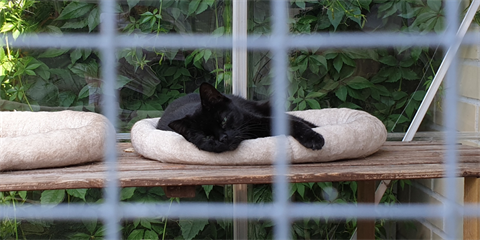24-hour cat containment

All cats within our municipality must be confined to their owner’s property, unless they are appropriately restrained in a cat carrier or on a leash. These requirements help:
- protect native wildlife
- stop nuisance behaviours like spraying, fighting and property damage
- reduce the feral cat population
- protect cats from injury and illness
According to the RSPCA, safe and reliable containment can be achieved by using an escape-proof contained outdoor area on the owner’s property e.g. via cat proof fencing or using netting or rigid wire to form a fully enclosed area or by keeping the cat contained indoors.
It is important your cat is microchipped and registered with Council so it can be returned to you as soon as possible.
Cat enclosures
Cats don't need to roam. If their basic needs are met, cats enjoy longer and healthier lives when safely contained to the property. A cat enclosure is a good option to contain your cat to your property. When building or purchasing a cat enclosure it is important to ensure adequate ventilation. It is also recommended to ensure you provide enough enrichment within the space, as this will help prevent them from being bored or developing any behavioural issues.
When training your cat to adapt to confinement it is recommended to skip the morning feed and feed your cat inside your house of an evening and to not let them out again until morning. You can then control and gradually extend the time your cat spends confined.
Adult cats used to roaming outdoors may have difficulty adjusting to confinement. If you are having issues, it is recommended to speak with your local vet.
Nuisance Issues
Did you know that it is an offence to allow your cat to remain on private property without the owners permission? Property owners may trap cats found trespassing on their property.
Serious problems can arise from outdoor roaming in cats, especially during nighttime, as approximately 80% of cat accidents occur during this period. Roaming cats risk getting hit by cars, engaging in fights leading to injuries, contracting fatal diseases like feline AIDS, and becoming lost. Additionally, roaming cats pose a threat to native wildlife as even well-fed cats may hunt. Furthermore, they may irritate neighbours through behaviours such as spraying, fighting, yowling, and digging in gardens.